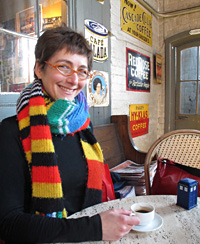Over the last couple of years, I've done a fair bit of work with - and for - designer Donna Druchunas. We first got to know each other through Knitty. She's been a columnist there for a number of years, focusing on knitting styles, techniques and traditions of other cultures.
I love working with Donna. Not only is she a great knitter, a fantastic designer and possessor of enormous amounts of knowledge about historical and regional knitting techniques, but she's also smart and funny and opinionated in a way I adore. I've learned a lot working with her, too: long tail CO over two needles as an alternative (and easier) provisional cast on!!!.
I've been thoroughly enjoying our latest project together: I have been doing the technical editing on her upcoming collaboration with June Hall, "Lithuanian Knitting: Continuing Traditions".
The book tells stories from Donna and June's travels around Lithuania, learning about the local knitting techniques and traditions.
The book also includes over 25 patterns for traditional and modern socks, gloves, mittens, and beaded wrist warmers, all worked with Lithuanian techniques, pattern stitches, and motifs. The techniques used include colorwork, texture stitches, lace, and entrelac. There's also lots of information on the techniques and traditional styles of knitting.
As a technical editor, I've learned tons from the patterns, and was utterly captivated by what Donna has written on special Lithuanian techniques.
Donna's got a pubslush fundraiser set up, essentially as a way to enable presales to fund the printing of the physical book. (Having self-published a book myself last year, I realized that this is a smart thing to do.)
Of course, with my technical editing perspective, I was interested in the technical side of the project, and Donna and I chatted about it.
Q: What technical challenges did you find in recreating/creating patterns for these designs?
A: The hardest thing was leaning the Lithuanian language well enough to read knitting patterns! That takes an extra level of work because knitting terms aren't defined in most dictionaries and sometimes the same words have one meaning in general conversation and another in knitting. For example, in Lithuanian the same word (akis) means eye or stitch, and the word raštai can mean either writing or pattern.
Q: What did you learn as you were building these patterns?
I learned a lot about how different kinds of yarns really change the results of a finished piece. You'd think after so many years of knitting and designing, I would have yarn substitution down pat! But I have several failed project samples in my box to prove that there's always more to learn. Lithuanian wool was very coarse compared to what we are used to today. When I tried to reproduce some of the designs in merino or other soft modern yarns, I was unhappy with the results and had to modify the patterns to suit the yarn. Some of the traditional techniques looked incredibly sloppy in softer yarns and others just didn't work at all. So in the book some of my designs are very close to reproductions of original pieces I saw in museum collections, while others are modern interpretations of Lithuanian styles of knitting.
Q: Where there any things you couldn’t figure out?
Not really. I have friends in Lithuania who are wonderful knitters and at my favorite yarn shop, Mezgimo Zona, I can always go for help! But because I am fluent in knitting, even though my Lithuanian language skills are mediocre at best, I was able to confidently translate knitting instructions. Perhaps I made some mistakes but I won't find out until some knitters in Lithuania read my books and email me! I love being corrected by Lithuanians. When someone in Lithuania corrects my language mistakes, I always feel like they are trying to help me and to understand me. When I was learning German, and a German speak corrected me, I often felt more like they were criticizing my lousy language skills.
When I took a class on making beaded wrist warmers from a Lithuanian teacher, and the class was in Lithuanian, I was able to understand the knitting part of the class. I did miss some interesting historical and cultural information that I learned later, though. I had thought men wore plain or neutral colored wristers, mittens, and gloves. But our teacher had told us in the class that men often wore the most colorful accessories and strutted around like peacocks showing off!
Q: Tell me a bit about the traditional pattern writing style that you find in old Lithuanian knitting books?
Well, most Lithuanian books didn't have pattern so much as basic instructions and models. For example, there would be a section explaining the steps to make a sock, including two or three options for working different heels and toes. Then there would be some photos of different socks, with a paragraph saying how many stitches the designer had cast on, what size needles she had used, and which heel and toe had been used. Sometimes charts are included for colorwork patterns, sometimes not. In other books, there are charts for entire mittens or socks, but no instructions. One thing I found very strange is that all of the mitten and sock charts have pointed tips for the toes and fingers, but the pieces in museums are almost all made with round shaping. Today in the markets, most mittens have the pointed shaping that we're used to seeing on Scandinavian mittens.
Q: Anything really cool about them that you wish we did in modern patterns?
I wish knitters today would learn conceptually how garments are constructed and then trust their knowledge so they weren't so tied to patterns. I learned by knitting from patterns, and I still enjoy knitting from patterns by other designers sometimes to relax, so I understand the need for patterns. But I think most knitters are smarter than they give themselves credit for, and they could easily recognize mistakes in patterns and customize designs to suit their tastes if they just had a little more confidence in what they already know! Buy a copy of Vogue Knitting's encyclopedia or something else similar, and read it from cover to cover several times. And study the patterns and schematics in your favorite books to see what you can learn about the basic shape and form of the types of garments and accessories you like to knit. That's the best advice I could give any knitter who wants to empower herself as a knitter.
More about the book here. You can find Donna on Twitter and Instagram, too.
Subscribe to:
Post Comments (Atom)








No comments:
Post a Comment